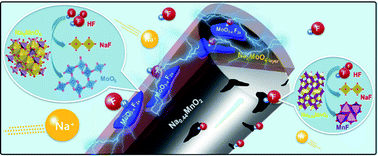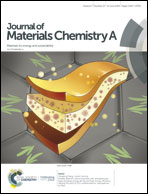Impact of Na2MoO4 nanolayers autogenously formed on tunnel-type Na0.44MnO2†
Abstract
We propose the coating of tunnel-type Na0.44MnO2 cathode materials with multi-functional Na2MoO4 nanolayers for use in rechargeable sodium batteries. Electro-conducting Na2MoO4 nanolayers (electrical conductivity of ∼103 S cm−1) are autogenously formed on the surface of Na0.44MnO2 particles through the reaction of (NH4)2MoO4 with surface sodium residues via melt impregnation at 350 °C. The Na2MoO4-modified Na0.44MnO2 electrode delivers discharge capacities of ∼120.4 mA h (g-oxide)−1 at 0.1C (12 mA g−1) and 79.7 mA h g−1 at 50C (6 A g−1). Moreover, with continuous cycling at a rate of 60C (7.2 A g−1), the Na2MoO4-coated Na0.44MnO2 electrode is able to retain a capacity of approximately 56 mA h g−1 without notable capacity fading for 1000 cycles. This achievement is attributed to the presence of Na2MoO4 on the active materials, which facilitates electron transfer during electrochemical reaction in Na cells. More interestingly, Na2MnO4 undergoes two-step HF scavenging to finally form MoO3−xF2x layers via an intermediate of H2MoO4 (MoO3·H2O) layers. The surface layers protect the active materials from HF attack in the electrolyte. These multi-functional effects of the Na2MoO4 and MoO3−xF2x surface layers are responsible for the long-term cycle stability of the cathode material for ultra-high-rate sodium storage applications.



 Please wait while we load your content...
Please wait while we load your content...